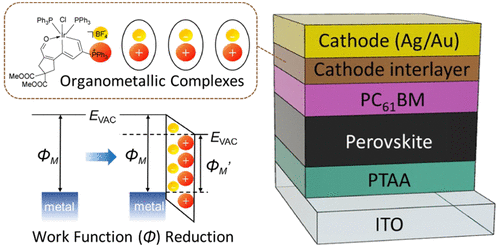当前位置:
X-MOL 学术
›
J. Am. Chem. Soc.
›
论文详情
Our official English website, www.x-mol.net, welcomes your
feedback! (Note: you will need to create a separate account there.)
Tuning an Electrode Work Function Using Organometallic Complexes in Inverted Perovskite Solar Cells
Journal of the American Chemical Society ( IF 14.4 ) Pub Date : 2021-04-27 , DOI: 10.1021/jacs.1c02118 Jiantao Wang 1, 2 , Jinhua Li 3 , Yecheng Zhou 4 , Chengzhuo Yu 1 , Yuhui Hua 3 , Yinye Yu 4 , Ruxue Li 5 , Xiaosong Lin 1 , Rui Chen 5 , Hongkai Wu 2 , Haiping Xia 3 , Hsing-Lin Wang 1, 6
Journal of the American Chemical Society ( IF 14.4 ) Pub Date : 2021-04-27 , DOI: 10.1021/jacs.1c02118 Jiantao Wang 1, 2 , Jinhua Li 3 , Yecheng Zhou 4 , Chengzhuo Yu 1 , Yuhui Hua 3 , Yinye Yu 4 , Ruxue Li 5 , Xiaosong Lin 1 , Rui Chen 5 , Hongkai Wu 2 , Haiping Xia 3 , Hsing-Lin Wang 1, 6
Affiliation

|
Low-work-function (WF) metals (including silver (Ag), aluminum (Al), and copper (Cu)) used as external cathodes in inverted perovskite solar cells (PSCs) encounter oxidation caused by air exposure and halogen-diffusion-induced corrosion, which threaten the long-term stability of the device. The cathode interlayer (CIL) has shown promise in reducing the metal WF and thus boosting the device power conversion efficiency (PCE). However, it remains a challenge for current CIL materials to enable high-WF metals (e.g., Au) to be used as cathodes to achieve PSCs with a superior PCE and long-term stability. Here, we use a series of synthesized (carbolong-derived) organometallic complexes as CILs to tune the electrode WF in inverted PSCs. Density functional theory calculations and surface characterizations show that the organometallic complexes that contain anions and cations are prone to form anion–cation dipoles on the metal surface, hence drastically reducing the metal’s WF. Photovoltaic devices based on a Ag cathode, which was modified with these organometallic complexes, received a boosted PCE up to 21.29% and a remarkable fill factor that reached 83.52%, which are attributed to the dipole-enhanced carrier transport. The environmental stability of PSCs was further improved after employing Au as a cathode with these organometallic complexes, and the modified devices exhibited no efficiency loss after 4080 h storage measurements.
中文翻译:

钙钛矿型倒置太阳能电池中使用有机金属配合物调节电极功函数
在倒钙钛矿太阳能电池(PSC)中用作外部阴极的低功函数(WF)金属(包括银(Ag),铝(Al)和铜(Cu))会由于暴露于空气和卤素扩散而导致氧化。腐蚀,威胁设备的长期稳定性。阴极夹层(CIL)已显示出减少金属WF并因此提高器件功率转换效率(PCE)的希望。但是,对于当前的CIL材料而言,如何使高WF金属(例如Au)用作阴极以实现具有优异PCE和长期稳定性的PSC仍然是一个挑战。在这里,我们使用一系列合成的(咔隆衍生的)有机金属配合物作为CIL来调节反向PSC中的电极WF。密度泛函理论计算和表面表征表明,含有阴离子和阳离子的有机金属络合物易于在金属表面形成阴离子-阳离子偶极子,从而大大降低了金属的WF。用这些有机金属配合物修饰的基于银阴极的光伏器件,其PCE值提高了21.29%,填充系数达到了83.52%,这归功于偶极子提高了载流子传输。在将这些有机金属配合物用作金的阴极后,PSCs的环境稳定性得到了进一步改善,并且经过修饰的器件在4080 h的存储测量后未显示出效率损失。用这些有机金属配合物改性的基于银阴极的光伏器件,其PCE值提高了21.29%,填充系数达到了83.52%,这归功于偶极子提高了载流子传输。在将这些有机金属配合物用作金的阴极后,PSCs的环境稳定性得到了进一步改善,并且经过修饰的器件在4080 h的存储测量后未显示出效率损失。用这些有机金属配合物改性的基于银阴极的光伏器件,其PCE值提高了21.29%,填充系数达到了83.52%,这归功于偶极子提高了载流子传输。在将这些有机金属配合物用作金的阴极后,PSCs的环境稳定性得到了进一步改善,并且经过修饰的器件在4080 h的存储测量后未显示出效率损失。
更新日期:2021-05-26
中文翻译:

钙钛矿型倒置太阳能电池中使用有机金属配合物调节电极功函数
在倒钙钛矿太阳能电池(PSC)中用作外部阴极的低功函数(WF)金属(包括银(Ag),铝(Al)和铜(Cu))会由于暴露于空气和卤素扩散而导致氧化。腐蚀,威胁设备的长期稳定性。阴极夹层(CIL)已显示出减少金属WF并因此提高器件功率转换效率(PCE)的希望。但是,对于当前的CIL材料而言,如何使高WF金属(例如Au)用作阴极以实现具有优异PCE和长期稳定性的PSC仍然是一个挑战。在这里,我们使用一系列合成的(咔隆衍生的)有机金属配合物作为CIL来调节反向PSC中的电极WF。密度泛函理论计算和表面表征表明,含有阴离子和阳离子的有机金属络合物易于在金属表面形成阴离子-阳离子偶极子,从而大大降低了金属的WF。用这些有机金属配合物修饰的基于银阴极的光伏器件,其PCE值提高了21.29%,填充系数达到了83.52%,这归功于偶极子提高了载流子传输。在将这些有机金属配合物用作金的阴极后,PSCs的环境稳定性得到了进一步改善,并且经过修饰的器件在4080 h的存储测量后未显示出效率损失。用这些有机金属配合物改性的基于银阴极的光伏器件,其PCE值提高了21.29%,填充系数达到了83.52%,这归功于偶极子提高了载流子传输。在将这些有机金属配合物用作金的阴极后,PSCs的环境稳定性得到了进一步改善,并且经过修饰的器件在4080 h的存储测量后未显示出效率损失。用这些有机金属配合物改性的基于银阴极的光伏器件,其PCE值提高了21.29%,填充系数达到了83.52%,这归功于偶极子提高了载流子传输。在将这些有机金属配合物用作金的阴极后,PSCs的环境稳定性得到了进一步改善,并且经过修饰的器件在4080 h的存储测量后未显示出效率损失。











































 京公网安备 11010802027423号
京公网安备 11010802027423号